Archives for workouts (page 6)
August 29, 2005
As concrete as it gets
The power rack project left behind a few sacks of concrete. Not wanting to waste that, figured I might just skip a few beats and ditch the wooden weight pit for a concrete one. After all, the few workouts I’ve done in it so far has convinced me this is one heck of an attraction.
I started work on this three weeks ago on the eve of leaving the summer cottage for the regular job in Helsinki. I did the frame one day until midnight, and then worked like a maniac the next day to get it all concreted before hopping on the southbound train with Rufus and Sanna. As we returned to celebrate the traditional Ostrobothnian end of the summer season on the last weekend of August, I got to uncover the now dry pit. Here’s the more than a thousand words thingy.
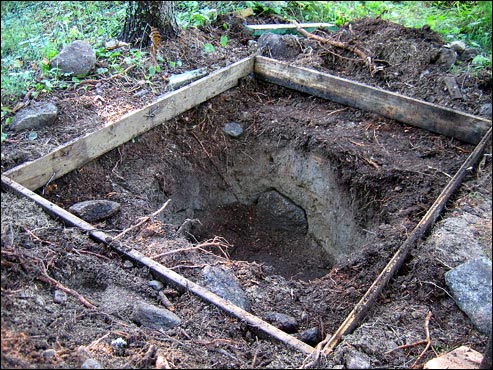
Step one: reluctantly tear down the “old” wooden top structure one has invested several hours in making, then put in an outer frame for the concrete and painstakingly make sure it is level in all directions.
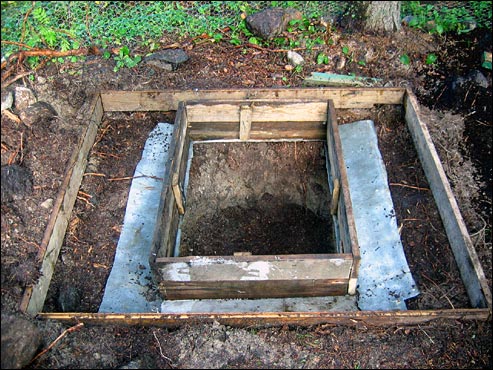
The inner frame in place. Notice the sheet metal that keeps the concrete from flowing down into the pit. The wood was ripped from old boards that once made up the weight shed at Toffe’s gym. The measurements correspond closely to that of the wooden pit, i.e. depth 60cm/23.4″, length 84 cm/32.8″, width 65 cm/25.4″.
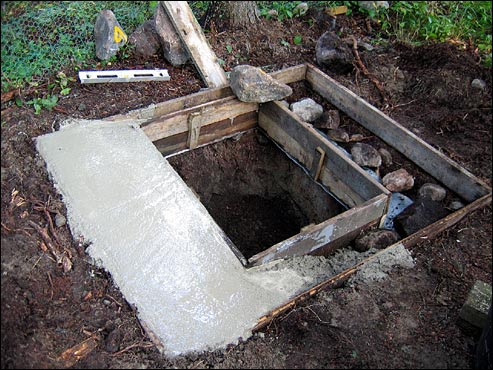
Partially filled frame. As usual, a few stones decorate the bottom in order to save some concrete.
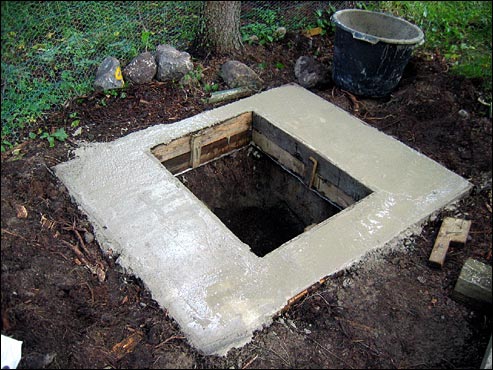
After sweating bucket loads whipping up several bags of concrete by hand, the frame was finally filled and the concrete carefully levelled out. Joy to the world!
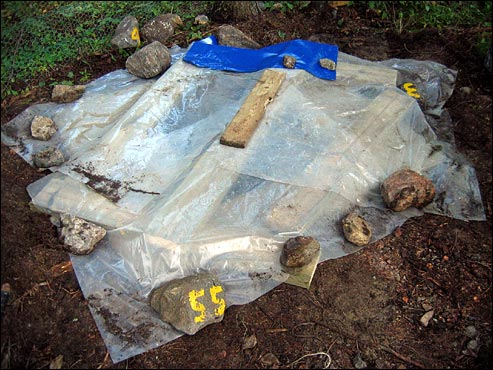
Ideally, concrete should be allowed to settle for a couple of days covered up to prevent moisture loss. The painted stones are fossiles from the flintstone’s era at Toffe’s when I used stones in buckets for resistance… This is how I left the pit before rushing off to the train via a quick dip in the sea (concrete in the ears does not make for a good public impression).
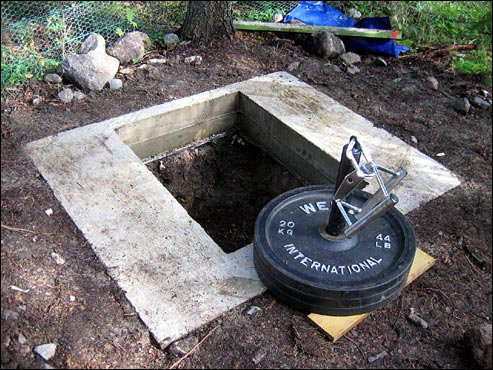
The uncovered pit upon the return a couple of weeks later. Guess who couldn’t wait to try it out… here the Ironmind loading pin is loaded to 60 kg/133 lbs for some light handle squats. Here’s the video (1.7M).
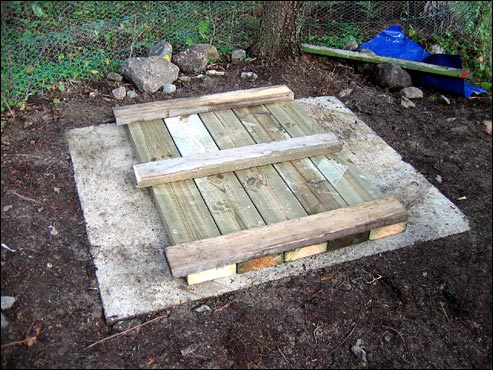
Holes in forests can be a deathtrap to both animals and humans alike as a poor mouse who fell into it can attest… not to mention how fun it is to step into a pit like this in the middle of the winter. For peace of mind, I nailed together a solid lid made of treated wood I bought for the purpose. I made sure to leave some gap between the boards to allow air to circulate (”hey, wanna try some handle deadlifts in my stinky pit?”). Mission complete.
August 18, 2005
Week 34: First free squats max and a floor press PR
Monday, 15 August 2005: SQ/DL
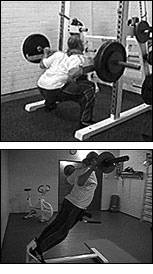 Over the two plus years I’ve been doing this powerlifting thing, I have never really gotten beyond the box squat. Last year, some four months after the infamous good morning injury, I had big plans for working with squat king Brent Mikesell on my form and embarked on free standing squats. Two workouts later, my lower back wasn’t worth the T-shirt it was draped in as I began a long struggle with recurrent low back problems. They are still with me it seems, but since I felt pretty ok I started to slowly work my way up. Things felt good, and I ended up maxing out at 100 kg/221 lbs and failing at 110 kg/243 lbs. Baby weights for sure, but this was a minor victory of sorts for me.
Over the two plus years I’ve been doing this powerlifting thing, I have never really gotten beyond the box squat. Last year, some four months after the infamous good morning injury, I had big plans for working with squat king Brent Mikesell on my form and embarked on free standing squats. Two workouts later, my lower back wasn’t worth the T-shirt it was draped in as I began a long struggle with recurrent low back problems. They are still with me it seems, but since I felt pretty ok I started to slowly work my way up. Things felt good, and I ended up maxing out at 100 kg/221 lbs and failing at 110 kg/243 lbs. Baby weights for sure, but this was a minor victory of sorts for me.
Comments on my squat form are warmly welcome (weekly video summary, 6.5M). One thing I notice from the video is that my lower back rounds at the very bottom of the squat. I’ve also started to wonder whether I am sitting back a little too much for a raw squatter. My knees hardly move forward at all, which is what an equipped squat should look like, but perhaps the price I am paying for not having any artificial support in the hole is that the upper body is forced forward a bit more than it should (admittedly, my core strength is also lagging). I remember reading somewhere that raw lifters can generally get away with a bit of forward knee movement. I need to experiment, it could well be that I could squat more weight if I came down straighter.
Another minor victory was getting hold on a copy of the EliteFTS Squat/Deadlift Exercise Index DVD from Voimaharjoittelu.net for a bargain 20 euros. A minor chip, hardly something that would bother me, was missing from the box which accounts for the whopping 39 euro saving compared to the retail price. That’s a great deal if any! After watching the DVD rave over the how effective a back piece the 45 degree hyper is and how you can easily get in and out by yourself with added weight, I looked at the school hyper with new eyes. Of course it doesn’t have the wide base and band pegs like the EliteFTS model, but it did turn out to be fairly easy to get in with a [light] barbell. The best thing ever, also gleaned from the DVD, were side bends with a dumbell on the same piece. Obliques burning in hell!
5 @ 40 kg/88 lbs
5 @ 50 kg/111 lbs
6 @ 60 kg/133 lbs
5 @ 70 kg/155 lbs
1 @ 80 kg/177 lbs
1 @ 90 kg/199 lbs
1 @ 100 kg/221 lbs
0 @ 110 kg/243 lbs
45′ back raise, barbell: 3x8 @ 35 kg/77 lbs
45′ back raise side bends, dumbell: 2x8 @ 18.5 kg/41 lbs
Wednesday, 17 August 2005: SQ/DL
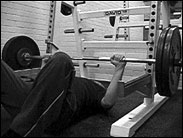 Yay! Following in the wake of a recent 105 kg/232 lbs decline bench PR, I managed the same on the floor press today. Moved on to 107.5 kg/238 lbs, but there was just a big BANG as I dropped it on the pins. Like on the declines, I made life simple and put 2.5 kg/5.5 lbs plates innermost to allow a smooth 10 kg/22 lbs pyramid all the way up to 105 kg/232 lbs. I don’t see much point in taxing the body with 100 kg/221 lbs if the goal is to do 105 kg/232 lbs. Better to just do 95 kg/210 lbs, then attempt 105 kg/232 lbs.
Yay! Following in the wake of a recent 105 kg/232 lbs decline bench PR, I managed the same on the floor press today. Moved on to 107.5 kg/238 lbs, but there was just a big BANG as I dropped it on the pins. Like on the declines, I made life simple and put 2.5 kg/5.5 lbs plates innermost to allow a smooth 10 kg/22 lbs pyramid all the way up to 105 kg/232 lbs. I don’t see much point in taxing the body with 100 kg/221 lbs if the goal is to do 105 kg/232 lbs. Better to just do 95 kg/210 lbs, then attempt 105 kg/232 lbs.
Satisfied. There is naturally footage on the aforementioned weekly video summary (6.5M).
8 @ 45 kg/99 lbs
6 @ 55 kg/122 lbs
2 @ 65 kg/144 lbs
1 @ 75 kg/166 lbs
1 @ 85 kg/188 lbs
1 @ 95 kg/210 lbs
1 @ 105 kg/232 lbs PR!
0 @ 107.5 kg/238 lbs
Cable front raise: 3x10 @ 30 kg/66 lbs
Close-grip pulldown with back against machine:
10 @ 50 kg/111 lbs
3x7 @ 70 kg/155 lbs
Seated cable L-flye: 2x12 @ 10 kg/22 lbs (?, didn’t record weight)
August 13, 2005
Week 33: Return of the teacher
All good things must come to an end, but why did I have to trade in the peaceful family existence at the summer cottage and Toffe’s gym for work this soon…? Why oh why?
Anyway. My dough will continue to come mainly from being a full-time teacher in a Swedish-speaking elementary school here in Helsinki (sixth grade). If last year is anything to go by, this will be a laborious yet rewarding year. With family and sleep high on the agenda, I will keep my usual freelancing activities (translating and teaching courses on Asia) to a minimum. On the training front, it is time to head indoors. For the time being, the natural place to go is the school gym. Only got one workout in this week though with a good headstart on 57.5 kg/127 lbs behind-the-neck presses. Also noted that my right wrist appears to be pretty sore after last week’s reverse grip benches. Got to lay off those for a while.
Behind-the-neck press:
worked up to 5,5,5,4,3 @ 57.5 kg/127 lbs
Close-grip bench, feet in air:
8 @ 40 kg/88 lbs
5 @ 50 kg/111 lbs
5 @ 60 kg/133 lbs
5 @ 70 kg/155 lbs
4 @ 80 kg/177 lbs
Bench shrug:
10 @ 60 kg/133 lbs
10 @ 70 kg/155 lbs
10 @ 80 kg/177 lbs
10 @ 90 kg/199 lbs
10 @ 95 kg/210 lbs
Close-grip pulldown: 3x12 @ 80 kg/177 lbs
Rope pulls: 2x12 @ 45 kg/99 lbs
August 8, 2005
Week 32: Bench shrugs and other fun things
Monday, 1 August 2005: ~SQ/DL
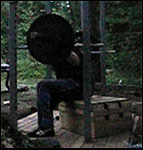 Ever the optimist, I had to try out my new squat box to the tune of Finnish metal band Teräsbetoni (eng. reinforced concrete). I find the heroic medieval battle lyrics to be a bit too much, but those who want something exotic might want to give the Metallitotuus album a whirl. Worked up to 90 kg/199 lbs and made the sensible decision to stop there. The back didn’t twist up too badly, but I could definitively feel it. Wrapped up with two non-stop ab circuits on the stability ball.
Ever the optimist, I had to try out my new squat box to the tune of Finnish metal band Teräsbetoni (eng. reinforced concrete). I find the heroic medieval battle lyrics to be a bit too much, but those who want something exotic might want to give the Metallitotuus album a whirl. Worked up to 90 kg/199 lbs and made the sensible decision to stop there. The back didn’t twist up too badly, but I could definitively feel it. Wrapped up with two non-stop ab circuits on the stability ball.
Box squat, 13″:
5 @ 50 kg/111 lbs
5 @ 60 kg/133 lbs
5 @ 70 kg/155 lbs
1 @ 80 kg/177 lbs
1 @ 90 kg/199 lbs
Swiss ball ab circuit (non-stop): 2 non-stop circuits of 20 reps each
crunch
left side bend
hyperextension
right side bend
Tuesday, 2 August 2005: Bench
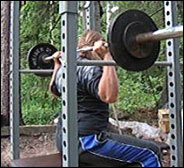 This was a great workout! For one thing, I was able to add another 2.5 kg/6 lbs on the behind-the-neck press for a clean 5x5 @ 55 kg/122 lbs. For another, it just plain felt great to be outdoors doing good stuff like reverse-grip benches, bench shrugs and lying rows. Since I finally caught the bench shrugs on tape (8.1MB), it is time to say a few words about this beast.
This was a great workout! For one thing, I was able to add another 2.5 kg/6 lbs on the behind-the-neck press for a clean 5x5 @ 55 kg/122 lbs. For another, it just plain felt great to be outdoors doing good stuff like reverse-grip benches, bench shrugs and lying rows. Since I finally caught the bench shrugs on tape (8.1MB), it is time to say a few words about this beast.
Bench shrugs involves assuming a normal benching position and then pushing the bar up by hunching the shoulders off the bench without bending the arms. This hits the pectoralis minor heavily. The first time I saw this exercise was on Blakley’s XTM bench tape where he called them “pec minor pops”. Blakley prescribes these for stabilizing the shoulder area to protect against the wear and tear of heavy lifting (as in shoulder pain). Recently, I was reminded of these when I read Kelso’s shrug book where they go under the logical name of “bench shrugs”. I am not including these based on any weakness analysis, but, like Blakley, Kelso assures his captivated reader that “this movement will [..] greatly strengthen the shoulder girdle for whatever purpose” (pp. 36). A strong shoulder girdle simply cannot be wrong.
Incidentally, 1960s bench legend Jim Williams, who sported an official 700 lbs/317 kg raw bench, was also a big fan of these “lying shrugs”. Unlike Blakley and Kelso, he always did these with dumbells for maximum range of motion. The chapter on Williams in The Bench Press by Biasiotto and Arndt does not specifically mention lying shrugs, but they are found in the attached program for 10 sets of 10 (pp. 60-61). I have no idea of the source, but I also found Williams’s own description of the movement cited on the Old School Strength Training board:
Now I will explain “my secret”-the lying shoulder shrug. After you are through with a light chest workout on the bench, find a pair of dumbbells that you can only get about 3 reps out of until failure, and as you increase in your shoulder strength, you will increase the dumbbell, even if you can’t press them once!
While lying on the bench, have 2 friends hand you the dumbbells. After doing the three reps, pause for about three exhales. Slowly let the shoulders slide down almost like relaxing. As they reach the desired angle, stop them and immediately raise them (by lifting them) as high as you can. This should be done with the dumbbells partially being held and partially lying on the delts. This should be done in sets of 10 reps, if you can, or one should work up to it. Remember, you are not pushing the weight with your triceps, because the problem is not in the completion, but the start. You may say, “Jimmy, why not use the bar?” A bar is what pins you to begin with, and secondly…it wouldn’t give you the necessary movement one needs in trying to shrug up and in. Some of the sensation that you may be able to relate to is like doing a complete dip, in which you let the body slide all the way down. Before your arms can come into play, you must first lift the body, than push with the arms. The same sensation happens at the end of he dip on a complete extension, when you cause the shoulders to raise the body.
Dips are not an easy answer because the shoulder movement in that excersise moves in a downward direction. But doing “my Shoulder Shrugs”, the shoulders move in an upward movement. How many times can I use this workout? It should be done during a training period for at least three times a week in a five-day-a-week training cycle.
Should I lose imediately on my bench? You should stabilize until shoulders gradually begin to heal. Upon the end of your training cycle, the lying shrugs should be stopped in favor of complete healing and growth. Remember, the heavier you can handle, the better. Dumbbells you can press for 6 reps to 10 reps are no good.
Add these shrugs to the rest of my workouts and you are sure to come up with the best bench press at any meet. Remember, this does not mean that you stop doing other shoulder work, but that my Shoulder Shrugs should be added.
As we Northern Europeans like to say, a dear child has many names. And that’s all I’m going to say about that.
worked up to 5x5 @ 55 kg/122 lbs
Reverse-grip bench, feet in air:
8 @ 50 kg/111 lbs
8 @ 60 kg/133 lbs
5 @ 70 kg/155 lbs
5 @ 80 kg/177 lbs
Bench shrug:
10 @ 60 kg/133 lbs
10 @ 70 kg/155 lbs
10 @ 80 kg/177 lbs
10,7 @ 90 kg/199 lbs
Lying rows, reverse-grip:
8 @ 60 kg/133 lbs
3x8 @ 70 kg/155 lbs
Sunday, 7 August 2005: Bench
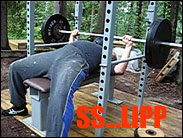 After the easy 105 kg/232 lbs decline, I figured the same on the vanilla bench would be child’s play. It wasn’t, but a nasty slip of the left foot on the wooden floor wetted by rain made sure I would never know. One word: rubber mat. Decided to get my feet out of harm’s way by raising them towards the sky. Got a very easy 90 kg/199 lbs on the reverse-grip bench with feet in the air, but for some ungroovy reason 95 kg/210 lbs was a total flop. Lying L-flyes.
After the easy 105 kg/232 lbs decline, I figured the same on the vanilla bench would be child’s play. It wasn’t, but a nasty slip of the left foot on the wooden floor wetted by rain made sure I would never know. One word: rubber mat. Decided to get my feet out of harm’s way by raising them towards the sky. Got a very easy 90 kg/199 lbs on the reverse-grip bench with feet in the air, but for some ungroovy reason 95 kg/210 lbs was a total flop. Lying L-flyes.
If you didn’t catch it already, here’s this week’s video summary (8.1MB). A tall order at 4:28, this will take some patience in today’s internet/remote control world. Evil.
6 @ 42.5 kg/94 lbs
5 @ 52.5 kg/116 lbs
5 @ 65 kg/144 lbs
2 @ 75 kg/166 lbs
1 @ 85 kg/188 lbs
1 @ 95 kg/210 lbs
0 @ 105 kg/232 lbs
Reverse-grip bench, feet in air:
5 @ 60 kg/133 lbs
1 @ 70 kg/155 lbs
1 @ 80 kg/177 lbs
1 @ 90 kg/199 lbs
0 @ 95 kg/210 lbs
Lying L-flyes:
6 @ 10 kg/22 lbs
July 30, 2005
Week 31: Heels over head
Monday, 25 July 2005
The assault on the behind-the-neck press continued. Last time I maxed out at 4 @ 55 kg/122 lbs, today a tight but clean 5x5 with only 2.5 kg/6 lbs less on the bar. Continued with the now standard feet in the air pressing, this time with a reverse grip, and bench shrugs. No big complaint was filed from the back department.
Reverse-grip bench, feet in the air:
8 @ 50 kg/111 lbs
8 @ 60 kg/133 lbs
6 @ 70 kg/155 lbs
Bench shrug:
10 @ 60 kg/133 lbs
10 @ 70 kg/155 lbs
10 @ 80 kg/177 lbs
Tuesday, 26 July 2005
After some preliminary core exercises, I stuck the pins in just below knee level. I had some doubts, but the therapist had, after all, assured me that I can continue training as normal. Rack pulls! Once I got up to 100 kg/221 lbs, the stiffness told me I wouldn’t be able to go much heavier. Decided to do one last set with 110 kg/243 lbs, but after only one rep I knew I had to call it a day. I was as crooked as… well, you know the drill. Did some ab circuits to get some blood flowing and then pulled myself straight again with some decompression and neural mobilisation exercises. Whatta life. ;-/
Walk outs with arm and leg lift: 10
Arm and leg extension kneeling on stability ball: 10
Rack pulls, below knee (4th pin):
10 @ 60 kg/133 lbs
10 @ 70 kg/155 lbs
10 @ 80 kg/177 lbs
5 @ 90 kg/199 lbs
5 @ 100 kg/221 lbs
1 @ 110 kg/243 lbs
Swiss ball ab circuit (non-stop): 1x5, 2x10 @ 5 kg/11 lbs plate
crunch: 15 @ bw, 10 @ 15 kg/33 lbs
left side bend: 15 @ bw, 10 @ 5 kg/11 lbs
hyperextension: 15 @ bw, 10 @ 15 kg/33 lbs
right side bend: 15 @ bw, 10 @ 5 kg/11 lbs
Friday, 29 July 2005
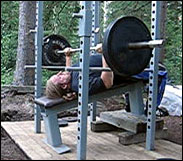 Woke up this morning and decided it was time for a decline bench press PR now that I had a good setup. I made 105 kg/232 lbs my goal, a good 5 kg/11 lbs increase over my previous max. To make for suitable weight jumps and easy plate switching, I loaded two 2.5 kg/5.5 lbs plates innermost and then only concerned myself with making the usual 10 kg/22 lbs jumps. Got it, and it was easy too. Anything after that, including a looney 105 kg/232 lbs attempt with chains, crashed faster than you can say bye.
Woke up this morning and decided it was time for a decline bench press PR now that I had a good setup. I made 105 kg/232 lbs my goal, a good 5 kg/11 lbs increase over my previous max. To make for suitable weight jumps and easy plate switching, I loaded two 2.5 kg/5.5 lbs plates innermost and then only concerned myself with making the usual 10 kg/22 lbs jumps. Got it, and it was easy too. Anything after that, including a looney 105 kg/232 lbs attempt with chains, crashed faster than you can say bye.
Wrapped up with some plate raises with two 15 kg/33 lbs plates sandwiched together. In retrospect, I was happy I didn’t drop one of them on my head… think twice before doing this with iron plates. Lying rows, then glow of PR satisfaction. The glow rubbed off on the video (2.5MB) in a flash gordon kind of way, epileptics beware.
5 @ 45 kg/99 lbs
5 @ 55 kg/122 lbs
1 @ 65 kg/144 lbs
1 @ 75 kg/166 lbs
1 @ 85 kg/188 lbs
1 @ 95 kg/210 lbs
1 @ 105 kg/232 lbs (PR!)
0 @ 107.5 kg/238 lbs
0 @ 105 kg/232 lbs + chains
Plate raise:
4 @ 30 kg/66 lbs
6 @ 25 kg/55 lbs
Lying row:
3x8 @ 70 kg/155 lbs
July 23, 2005
Week 30: Anticlimax
Thursday, 21 July 2005: Structural balance test
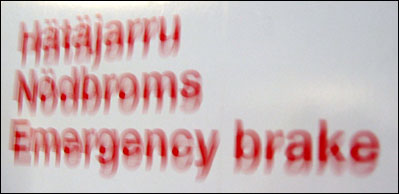
While I was leading a computer-free existence at the summer cottage, a tidal wave known as Achieving Structural Balance by Charles Poliquin swept over the known powerlifting blog world (for example Stinn, Scott, Alberto, John M) in no time under the helm of Alberto “Prilepin” Caraballo. The article presents an unambigious testing protocol for determining whether a particular muscle weakness is holding back strength gains.
From all my reading of Russian weightlifting texts lately, I have come to appreciate the fact that all strength is neural in origin and that your voluntary 1RM lies well below the force the muscles are capable of. Neural feedback mechanisms, although quite conservative in most human beings, make sure that force production does not rise to levels where the muscles could injure themselves (as in muscles ripping themselves to pieces). Poliquin’s argument is that structural strength imbalances will similarly limit force production across the board as the body attempts to cover for its weakest link. He goes on to say that weak rotator cuffs often keep athletes from making further progress in the bench press. Based on normative data collected from several hundred athletes Poliquin has worked with, the protocol posits percentages of the close-grip 1RM that the athlete should be able to do in a number or exercise. This line of thinking is old hat in at least East Bloc countries where quite precise numbers have been developed for various proficiency levels of weightlifting (for example, see Roman 1988: The Training of the Weightlifter, pp. 101-104), but this is the first time I see it appear in a form readily applicable to a powerlifting exercise. Still, I bet some powerlifting coaches have similar numbers worked out.
Here’s Poliquin’s optimal strength ratios based on my current 100 kg/221 lbs close-grip bench press PR:
Absolute score: 100 kg/221 lbs
Relative score: 100%
Incline Barbell Press
Absolute score: 83 kg/183 lbs
Relative score: 83%
Supinated Chin-Ups
Absolute score: 81 kg/179 lbs
Relative score: 81%
Behind-the-Neck Presses
Absolute score: 64 kg/141 lbs
Relative score: 64%
Scott Barbell Curls
Absolute score: 46 kg/102 lbs
Relative score: 46%
Standing Reverse Curls
Absolute score: 30 kg/66 lbs
Relative score: 30%
External Rotation SA (for eight reps)
Absolute score: 9 kg/20 lbs
Relative score: 9%
I knew without testing that my incline press and standing reverse curls were right at the mark. After doing some too close close-grip benching that caused me to barely fail 100 kg/221 lbs and some lame pin presses that broke some mouldy PRs, I tested the supinated chin, outer rotation and scott curls (over a board rigged in the rack). Clocked in at 104 kg/230 lbs with all my gear and fatherhood fat, but still got 1½ strict chins (sigh, still remember how easy it was to chin when I weighed 80 kg/177 lbs). As a guy who has always done a reasonable amount of cuff work, the external rotations passed… barely. The scott curls weren’t even close. The recent 4 @ 55 kg/122 lbs on the behind-the-neck press should just about be enough for the required 65 kg/144 lbs press; definitively not something I could have achieved just a few weeks earlier.
In a sudden twist worthy of a nightmare, I never got around to the post-workout shake. Instead I plunged back into dark times as my lower back again decided to go spastic (picture with added lines for emphasis - still quite a moderate case). The cramp largely subside after I did the neural mobilisation exercises, but the reappearance of the dreaded drooping shoulder was enough to put a big dent in my mood. After feeling sorry for myself for an undisclosed amount of time, during which I even considered giving up powerlifting altogether, I took the venerable bull by its horns and vowed to get back into rehab even if it would set my squat and deadlift ambitions back another year. Shit happens it seems, but I couldn’t help wondering whether the recent visit to the back clinic had been a capital mistake. Had the adjustment upset some precious balance causing the body to rebel?
8 @ 40 kg/88 lbs
5 @ 50 kg/111 lbs
3 @ 60 kg/133 lbs
3 @ 70 kg/155 lbs
1 @ 80 kg/177 lbs
1 @ 90 kg/199 lbs
0 @ 100 kg/221 lbs
Pin press, low range lockout:
5 @ 60 kg/133 lbs
3 @ 80 kg/177 lbs
3 @ 100 kg/221 lbs
2 @ 120 kg/265 lbs
1 @ 122.5 kg/271 lbs
0 @ 130 kg/287 lbs
0 @ 125 kg/276 lbs
Supinated pull-up: 1½ @ bodyweight (104 kg/230 lbs with all gear on)
Outer rotation (seated dumbell L-flye):
8 @ 6 kg/13 lbs
8 @ 10 kg/22 lbs
Seated scott curl (over padded inclined board in power rack):
3 @ 30 kg/66 lbs
1 @ 40 kg/88 lbs
0 @ 45 kg/99 lbs
0 @ 42.5 kg/94 lbs
Saturday, 23 July 2005: Rehab
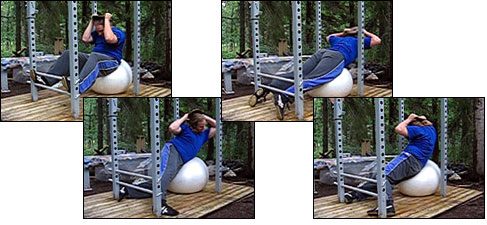
For obvious reasons, I dedicated this workout to pure rehab. The back was feeling a bit better and I had regained some optimism about the future. Nice and easy, nice and easy for now. The core of the workout was a swiss ball ab circuit (crunch, side bend, hyperextension) with feet supported against the two safety pins set low in the rack. As cliché as it might sound, this combo is a winner. See it sung on the weekly video summary (8 MB) to the tune of Children of Bodom’s cover of the Maiden classic Aces High.
Walkouts with alternate arm and leg lift: 10, 8
Swiss ball ab circuit (non-stop): 1x5, 2x10 @ 5 kg/11 lbs plate
crunch
left side bend
hyperextension
right side bend
July 18, 2005
Week 29: Quick detour indoors
We decided to stay in Helsinki for a few days before returning to the summer cottage for the last three weeks of my summer vacation. Took this opportunity to do a couple of sessions with Måns focusing on a bit of cable work and other stuff that I can’t do at Toffe’s Gym.
Friday, 15 July 2005
There is something that haunts us at the Töölö Gym. Like last time, we managed to arrive 30 minutes before closing time. This time there was a green poster on the door that exclaimed “the gym will close at 7pm on Fridays, ONLY on Fridays”. After a few obligatory sighs, we decided to just head back to World Class for a second visit since we like the laid back atmosphere. The music still sucked (how do you spell schlager?) , but got in a good workout. Worked up to a 4RM on the behind-the-neck press. Also found that a 25 kg/55 lbs is about all I can handle on the plate raises.
5 @ 40 kg/88 lbs
5 @ 50 kg/111 lbs
4 @ 55 kg/122 lbs
8 @ 45 kg/99 lbs
Close-grip bench:
5 @ 40 kg/88 lbs
5 @ 50 kg/111 lbs
5 @ 60 kg/133 lbs
5 @ 70 kg/155 lbs
5 @ 80 kg/177 lbs
Wide-grip pulldown, front: worked up to 3x8 @ 17 plates (unmarked)
Plate raise:
8 @ 10 kg/22 lbs
8 @ 15 kg/33 lbs
8 @ 20 kg/44 lbs
8 @ 25 kg/55 lbs
Standing barbell curl: 6,5 @ 40 kg/88 lbs
Total training time: 65 min
Sunday, 17 July 2005
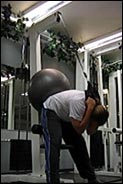 Third time’s the charm at Töölö Gym. I had forgotten my lifting shoes at the summer cottage, so figured I might just as well give the Hack deadlifts another go. 130 kg/287 lbs went up without too much effort, so gave 140 kg/309 lbs a shot. Came up, but didn’t make it to the summit. 135 kg/298 lbs was closer, but it was still too much after the 140 attempt. Overall a much more solid performance than two weeks ago, but no new shiny PR this time. Next found myself a lower pulley and worked up to a near max 15 reps with the 120 kg/265 lbs stack. Finished off with some of those standing cable crunches against a stability ball that seemed so popular over at Metal Gym (sans the bands though). The ball was a bit too foamy for my taste, it even said Foam something on it. QUICK! Here’s the video!!! CATCH!
Third time’s the charm at Töölö Gym. I had forgotten my lifting shoes at the summer cottage, so figured I might just as well give the Hack deadlifts another go. 130 kg/287 lbs went up without too much effort, so gave 140 kg/309 lbs a shot. Came up, but didn’t make it to the summit. 135 kg/298 lbs was closer, but it was still too much after the 140 attempt. Overall a much more solid performance than two weeks ago, but no new shiny PR this time. Next found myself a lower pulley and worked up to a near max 15 reps with the 120 kg/265 lbs stack. Finished off with some of those standing cable crunches against a stability ball that seemed so popular over at Metal Gym (sans the bands though). The ball was a bit too foamy for my taste, it even said Foam something on it. QUICK! Here’s the video!!! CATCH!
10 @ 50 kg/111 lbs
5 @ 60 kg/133 lbs
5 @ 70 kg/155 lbs
5 @ 80 kg/177 lbs
3 @ 90 kg/199 lbs
2 @ 100 kg/221 lbs
1 @ 110 kg/243 lbs
1 @ 120 kg/265 lbs
1 @ 130 kg/287 lbs
0 @ 140 kg/309 lbs
0 @ 135 kg/298 lbs
Pull-through, bent-legged:
10 @ 40 kg/88 lbs
8 @ 60 kg/133 lbs
8 @ 80 kg/177 lbs
8 @ 100 kg/221 lbs
15 @ 120 kg/265 lbs
Standing cable crunch with stability ball: 3x8 @ 4 plates (40 kg/88 lbs?)
July 10, 2005
Week 28: Finished weight pit

Finished the weight pit by building the top structure for it. In the process, I also decided I wanted it a tad deeper to allow for an extreme range of motion if needed. Unfortunately, Murphy’s law dictates that when digging in forrests large rocks will always materialize where they do most harm. After barely managing to deadlift the largest one out of there, I promptly added it to the growing collection of lifting stones I plan to have at Toffe’s Gym. The top structure is basically a lid made of treated wood (floor boards from my retired squat rack) resting on a lot of carefully placed stones to make it perfectly level in all directions. I did my share of jumping on it to verify that it is indeed rock solid, but might concrete it in a year or three if this turns into a permanent attraction. Whenever I build something for my gym, my motto is that it should be able to accomodate whatever unexpected strong company I might get.
The measurements for the finished pit are as follows: depth 60cm/23.4″, length 84 cm/32.8″, width 65 cm/25.4″. Besides the now staple handle squat, the measurements should accomodate a very wide range of exercises including bent over rows, curls, forearm rollers, stiff legged handle deadlifts… even shrugs. In fact, if you need an outdoor gym on the cheap, a pit combined with some plates, a loading pin and a couple of handles (V-bar, straight) will allow you to do most any exercise where you have the weight below you at the start. Still, your mother is liable to call it a grave.
Wednesday, 6 July 2005
After all that digging, I kept this short. Turned out to be the last workout for a week as I picked up my rack from the welder on Thursday. Before I knew it, I was preoccupied with hauling 1000kg/2210lbs of concrete by boat to Toffe’s Gym…
Bent-over handle row: 2x8 @ 60 kg/133 lbs
Stability ball crunch: 30
July 3, 2005
Week 27: Hack, hack, hack
Monday, 27 June 2005: Bench
Quick and light as this workout might have been, it caused major soreness. Soreness = BIG no-no according to the Westside core litterature I’m wading through. Will elaborate on this later when I start organizing my reading notes. As a side note, this was the first time I ever did plate raises (front raises with a plate held by both hands). Delts, delts…
Plate raise: worked up to 2x10 @ 20 kg/44 lbs
Standing barbell curl: 3x10 @ 30 kg/66 lbs
Thursday, 30 June 2005: Squat/dead
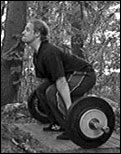 Still a rackless sucker, I had to come up with something else to do off the floor. Perhaps it was because it is one of Ano’s favorites, because Louie Simmons says it is great for deadlift starting strength, or because I told Scott way back that “I’d try them Wednesday“. Be that as it may, figured Hack Deadlifts (aka Hack Squats, aka Hack Squat Deadlifts, aka Behind the Back Deadlifts) would be both fun and instructive to try for the first time. Because the weight is further behind than on the conventional deadlift, I figured this might just be a helpful exercise for learning to lean less forward. This turned out to be partially true, but as the last couple of sets prove (VIDEO 3.1M), it is indeed possible to lean a bit on these as well… first time, first PR at 130 kg/287 lbs. Another keeper for sure.
Still a rackless sucker, I had to come up with something else to do off the floor. Perhaps it was because it is one of Ano’s favorites, because Louie Simmons says it is great for deadlift starting strength, or because I told Scott way back that “I’d try them Wednesday“. Be that as it may, figured Hack Deadlifts (aka Hack Squats, aka Hack Squat Deadlifts, aka Behind the Back Deadlifts) would be both fun and instructive to try for the first time. Because the weight is further behind than on the conventional deadlift, I figured this might just be a helpful exercise for learning to lean less forward. This turned out to be partially true, but as the last couple of sets prove (VIDEO 3.1M), it is indeed possible to lean a bit on these as well… first time, first PR at 130 kg/287 lbs. Another keeper for sure.
5 @ 60 kg/133 lbs
5 @ 70 kg/155 lbs
5 @ 80 kg/177 lbs
5 @ 90 kg/199 lbs
5 @ 100 kg/221 lbs
2x1 @ 110 kg/243 lbs
1 @ 120 kg/265 lbs
1 @ 130 kg/287 lbs
2x0 @ 135 kg/298 lbs
Straight-legged sit-up on bench:
20 @ bodyweight
7,5 @ 5 kg/11 lbs
Arm and leg extension kneeling on stability ball: 12
Saturday, 2 July: Bench
Upped the weight on the behind-the-neck presses. 5x5 @ 50 kg/111 lbs started being tight, but I got it.
Close-grip bench with feet in the air: worked up to 3x5 @ 70 kg/155 lbs
Lying L-flye: 2x15 @ 6 kg/13 lbs
Bench shrug: 2x10 @ 70 kg/155 lbs
June 26, 2005
Week 26: Construction site philosopher in training
Squat racks razed to the ground. Huge rocks unearthed. Long-term readers will recall the mayhem that I orchestrated at my outdoor gym at the end of last year’s summer training season in order to accomodate for a power rack and heavy duty bench that were to be welded out of iron junk. In the end, the promised welder never showed up and the iron was left alone to hibernate under a big pile of snow. Not wanting to spend another rackless summer at Toffe’s Gym, one of the first things I did upon returning this year was to get me another welder who promised to deliver the goods within the first week of July. Meanwhile, I am relegated to training at what can best be described as a construction site equipped mainly with iron, my donkey calf machine and an old Weider bench standing on a level wooden platform. The spruces swaying in the fresh breeze from the sea made sure I still felt like I had just returned to my own little powerlifting mecca.
Tuesday, 21 June 2005: SQ/DL
After the recent deadlift assault, squatting was on the agenda. More specifically, something that would be beneficial for curing the excessive forward lean and leg drive issue that is the sorry hallmark of both my squat and deadlift. I won’t pretend that I will start to do these exercises with a near straight back overnight simply overriding current weaknesses (long back and thighs don’t help much either), but if I could get to the point where I can drive straight up from whatever forward lean I have at the bottom it would be a great start. Once I start to ascend, I must not yield an inch forward, come rain or shine.
Standing out there in the woods at past midnight (blessed be the bright Finnish summer nights) without any kind of rack, my mind wandered in mysterious ways and suggested I try Zercher squats off the floor. This is the way they were originally performed before, according to Louie Simmons on the older Deadlift Secrets video, the much increased mass of the modern powerlifter prevented going that deep. There is really no reason to drop down just to the thigh or just past the knees if one is physically able to go all the way. For one thing, the lift becomes dramatically more challenging thus sparing the poor elbow crooks from heavier weights while really forcing the lifter into an extreme forward lean and deep squat that are sure to overload a muscle or two as the body must work even harder to stay upright. Being the zealot I am, I will henceforth regard everything else than off the floor a partial Zercher squat. ![]()
To the tune of the humming mosquitoes, I slapped one wheel on the bar and found that I was just barely able to go down into a squat deep enough to get the bar into the crook of my arms. What I also found was that 60 kg/133 lbs was already too heavy for me to manage in good form. I dropped down to 50 kg/111 lbs, which worked great although the smaller plates did not permit me to touch the floor between every rep. This is without doubt the most demanding two-legged barbell squat exercise I’ve tried so far. If anyone out there tries the full-range Zercher, I would be more than a little interested in what poundages you can muster up without turning it into a Zercher deadlift. Anyway, if you have three minutes to spare, the nocturnal Zercher action can naturally be found on this week’s video summary (5.2M).
3, 1 @ 60 kg/133 lbs
5,3,4 @ 50 kg/111 lbs
One-handed deadlift with barbell:
5 @ 40 kg/88 lbs
5 @ 50 kg/111 lbs
Stability ball crunch:
30 @ 5 kg/11 lbs
2x15 @ 10 kg/22 lbs
Walk outs with arm and leg lift: 5
Friday, 24 June 2005
On the upper body front, I’ve decided to declare war on the shoulders. In my bodybuilding days I came to regard the shoulders as my strongest body part as I could move the same weight on the seated dumbell press as on the incline (32 kg/71 lbs dumbells appeared very heavy back then). Photos from that time also show a guy with huge shoulders and a fairly flat chest.
I do realize the importance of extra shoulder work for raw lifters, but somehow I’ve carried the illusion of shoulders not being a personal problem over the fence into the powerlifting world. Well, I can now bench a lot more than I could back then and it would be naive to pretend that the shoulders are evolving at the same speed as my other muscle groups without doing much extra work for the front delts (always been big on preventive cuff work). As John McDonald pointed out to someone somewhere recently, all the old-time big benchers did tons of shoulder work according to Biasiotto’s and Arndt’s book The Bench Press. I should know that, heck, I’ve even reviewed the book, but blinders are per definition blinders. We raw lifters have a lot to learn from the era before heavy duty bench shirts made powerlifting revolve increasingly around having an overwhelming lockout to augment the drive that the shirt gives out of the bottom. To make things even more plain, it has been clear for a long time now that my sticking point in the bench press is precisely at the point where the delts give over to the triceps. Suddenly the idea that I have seriously neglected shoulder work and that they might be the main hindrance to me pushing up bigger weights on the bench does not appear so far fetched anymore. After all, I have been complemented on my strong lockout more than once and the fact that I can lockout 70 kg/155 lbs more for a triple than I can bench off my chest should tell a listening ear something. ‘Nuff said.
Close-grip bench:
10 @ 45 kg/99 lbs
10 @ 60 kg/133 lbs
5,4 @ 70 kg/155 lbs
Bench shrug: 3x10 @ 60 kg/133 lbs
Lying L-flye:
6 @ 11 kg/24 lbs
15 @ 6 kg/13 lbs
Saturday, 25 June 2005
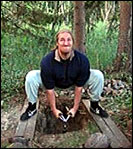 My mind continued to bubble towards the end of the week. On an impulse I grabbed a shovel and started digging my way past roots and stones into the ground. Come Saturday, my new pit was basically done except for a permanent top structure. Good enough for the second novelty of the week - handle squats. I first saw these on the Westside Squatting Secrets tape where Louie explained how Westside lifters would complement all the box squatting with belt or handle squats to keep the quadriceps up to par. I grabbed my Ironmind loading pin that I bought last year, threw on a few plates, attached my V-bar handle on it and had a go. Reviewing the ensuing video footage, I was more than pleased with my drive off the bottom as the tendency to lead with the legs was only barely noticable. I love this movement already.
My mind continued to bubble towards the end of the week. On an impulse I grabbed a shovel and started digging my way past roots and stones into the ground. Come Saturday, my new pit was basically done except for a permanent top structure. Good enough for the second novelty of the week - handle squats. I first saw these on the Westside Squatting Secrets tape where Louie explained how Westside lifters would complement all the box squatting with belt or handle squats to keep the quadriceps up to par. I grabbed my Ironmind loading pin that I bought last year, threw on a few plates, attached my V-bar handle on it and had a go. Reviewing the ensuing video footage, I was more than pleased with my drive off the bottom as the tendency to lead with the legs was only barely noticable. I love this movement already.
Stiff-legged handle deadlift:
8 @ 40 kg/88 lbs
8 @ 60 kg/133 lbs
Bent-over handle row: 3 @ 60 kg/133 lbs (aborted as lower back felt fried)